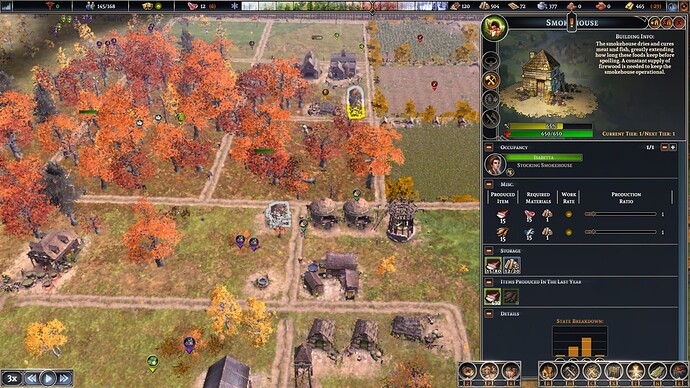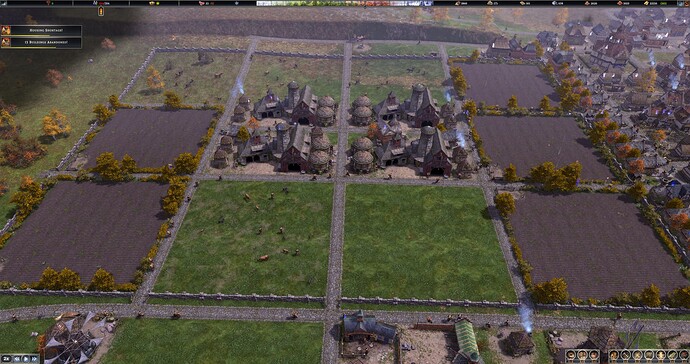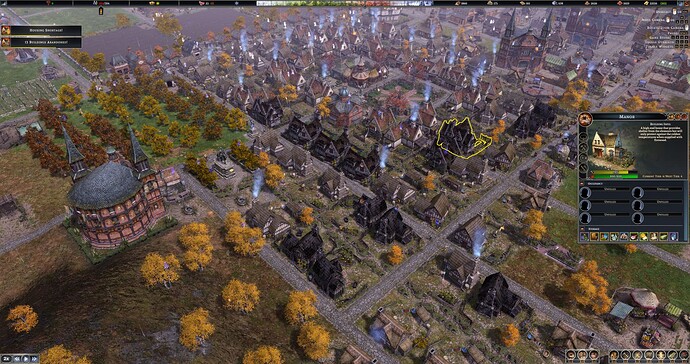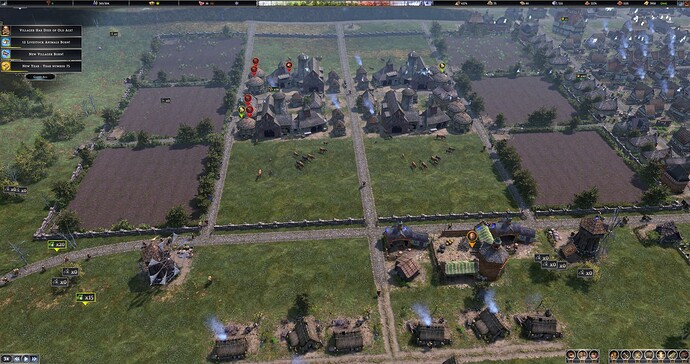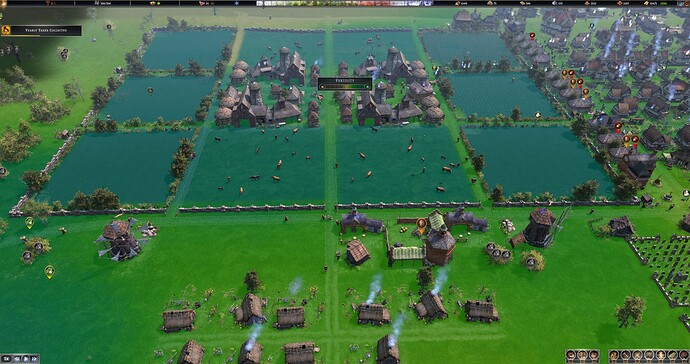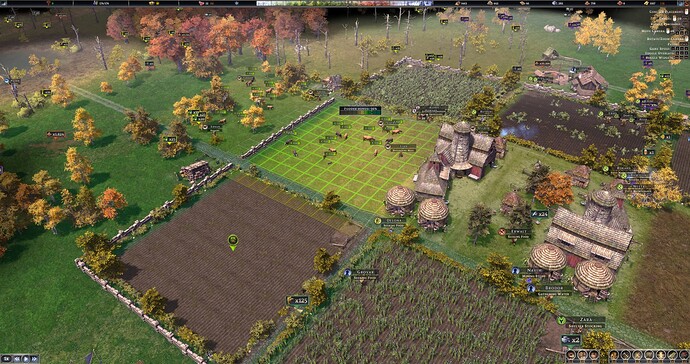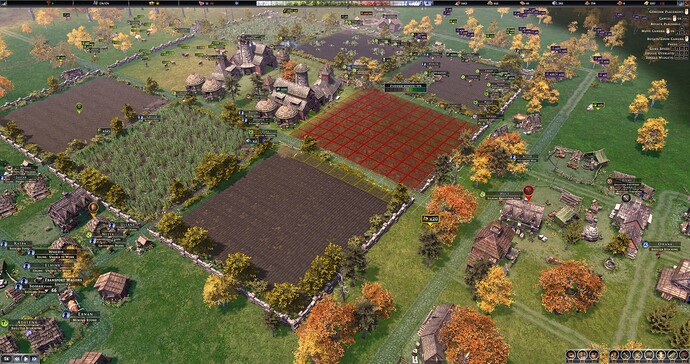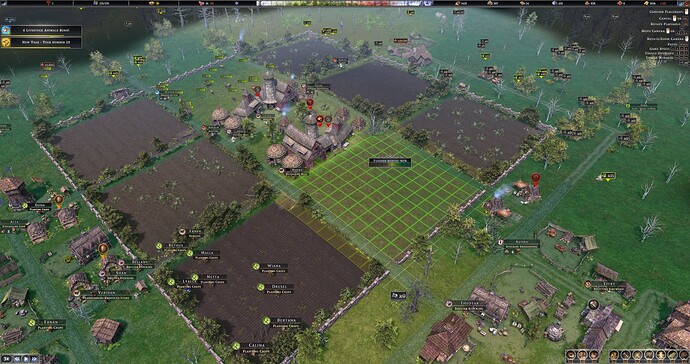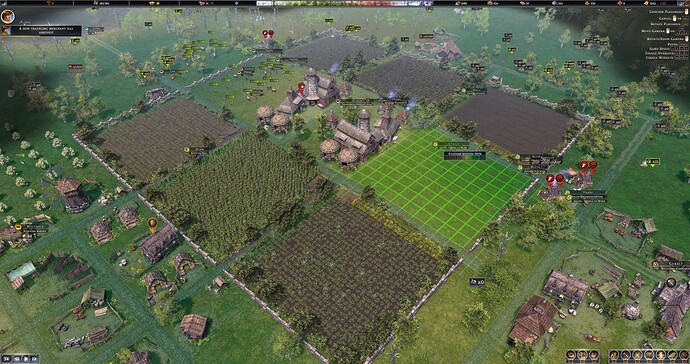There are a lot of studies in pubmed that have searched for something and failed to find it, but they are posting unsuccessful results. I would like it to be the same here. Despite such a cool study, a negative result is also an amazing result. Other people, seeing such a study, may gain confidence that even with a high probability of a negative result, the study itself will be very exciting. For example, I am currently very inspired by the author of this topic to also explore an interesting topic for me, so it’s sad that the main topic message was changed to a simple negative result
@Celebrindan Petition to change the title to “Pasture to Farm Transition Experiment”! Yeay data!
You should consider to name it:
“Pasture to Farm Transition, MOO !”
Cows just wanna have fun =)
I don’t remember the highest Smoker production we had seen yet, but with this set up I have one smoker that did 630 a year.
Just released the SE pasture to fodder, getting ready for the sixth farm.
460+ inhabitants, plenty of food.
Then, seven strangers come knocking on my door.
I’m three taps away from finishing this shelter for them…
… and this happens.
Do not accept new people unless you have shelter prepared for them in advance.
The last straw, and a puff of wind…
780
I’m moving all the Smokers to the center and the Granaries to the spots the smokers are in now, next to the Farm fields.
As soon as the wheat farmers step off their Farm fields, they will be next to a Granary.
I’m also removing the roads between the two east Barns and the fields next to them that will be their pastures.
This will give me one extra space between barns running north and south.
I think I can add one or two extra Smokers and another Root Cellar, and need one less Well (with all the smokers clustered in the center).
Is there a way to restore your posts, @Celebrindan? I think they would still be very interesting and helpful for a lot of people.
I still have the screenshots, but I think this one has the best information for farm and pasture management and food supply needs.
500+ population
16 (4) month food supply, from-
6 Farm fields
4 Barns & pastures
1 Chesemaker
12 Smokehouses
8 Granaries
2 Windmills
5 Bakeries
3 Hunter Shacks
2 Fishing Shacks
5 Foraging Shacks (willow prioritized)
7 Compost Yards
3 Arborists
3 Preservers
Plenty of food for people and feed for animals.
Everything in this picture is placed for maximum performance.
Raw meat and milk do not find their way into the shelter stocking or finding food worker tasks, reducing the number of non-productive hours spent in transit.
Grain is processed at full speed by two windmills supplying five bakeries that do not overproduce, because of their diverse locations, but there is still plenty of grain for animal feed.
Milk is processed to cheese long before it goes to waste and before people can take the fast-spoiling goods.
Processed food goods are stored in Root Cellars located between the population center and the raw goods processing units, meaning those searching for food will more often than not, come upon the processed long-shelf life goods well before they get to the raw materials.
Placing the Granaries contiguous to the Barns will ensure the animals get plenty of winter feed.
The compost yards and one planting of clover per year keep the fields at 100% fertility (Idyllic Valley), with some years having to carryover compost because 100% across the board fertility.
That’s when I throw in an extra crop of carrots.
Placing the Smokehouses in the center allows them to all be within six spaces of the single, central well, for when they catch fire, as they are wont to do.
Placing the Granaries at the ends puts them all within three steps of the farm fields which raise the grain.
The two Windmills have straight-line access to all eight of the Granaries.
The Smokehouses all have quick access to firewood and immediate access to Root Cellars that accept only Raw Meat and Milk.
The Cheesemaker catches the raw milk and swiftly converts it to cheese.
Time wasted stocking shelters with raw goods is reduced to a minimum.
Current fertility-
Ya editing the posts so there is no context to the conversation has made this post useless. I’m sure I would have been interested in this post as this level of game mechanic is my interest and I would have been interested interacting with this post. But there is no point with all the edits. Poor etiquette
The information & data gathered in furtherance of transitioning Barn pastures to Farm fields was useless.
The time spent waiting for a pasture to become super-fertile is the same amount of time it takes for a farm to ‘clover-up’ to 100% fertility.
Layout of a central Barn square, the useful elements that increase its productivity and the problem of animals starving in winter, was the most significant information gathered.
These advantages are still covered here.
This example of six farms and four pastures will feed well more than 500 population.
The information of what doesn’t work so well, and the thoughts that went into your setups, the ideas, all of that is far from useless, I think. It helps with understanding some of the not so obvious mechanics, and it was nice of you to share it. Many of your later optimizations are probably more obvious or intuitive to understand, though I must admit, it’s a sweet setup (efficiency-wise, I still won’t plan with flat squares  ).
).
In the end, it’s your thread, and I can understand the frustration when something doesn’t work out as planned - but I still think your posts had merit. Plus, anyone coming to this thread now must be so confused! Maybe you can at least put your conclusions in the first post, so they’re easier to find for readers stumbling about the thread, and help give context?
I am not sure you realize how valuable the data you looked at was. Even though it might have been rendered moot, it looked at things in a new way and gave ideas of setups and rotation. It gave the opportunity to look at things and try things in a new way.
I have NEVER had as much smoked meat as I have now.
You did fantastic work. 
Thank you both.
Me yammering on doesn’t matter as much as the results.
Anyone can use this template and easily get to a population of at least 500 with plenty of food in sandbox mode.
I’m thinking of trying a regular map next time and having a reasonably secure food-plan may be of help.
I will orient the four-side of the grid towards the population on my next map, rather than the three-field side, and allow a bit more room between the homes and the farm fields, which seem ‘so far’ away in the beginning. 
However, it does require culling the herds at 3 mo intervals, rather than setting the herd size to autopilot, in order to maximize volume and longevity of the smoked meats food product.
This is something else I’ve learned.
A herd size of 12 is optimal for improving/maintaining fodder quality.
But, if you set your herd-size to 12 it stunts the quantity in growth of the newborn to two.
Where, if you set the herd-size to 16 (max), and manually cull back your herds with the Slaughter button to 12 each year, you get three newborn per year, per Barn, and you can choose when the meat hits the shelf for smoking.
Which is critical in preventing massive rot and in preserving a very large quantity of the long shelf-life food source.
It also lets you choose the lowest fodder-quality field for slaughter first, then up the ladder, which adds to fodder-quality improvement characteristics.
Autopilot (herd-size setting) does all of this while flooding the Root Cellars with multiple-thousands of pieces of raw meat all at once in the Spring.
Set your herd-size to max, 16, and cull back to 12 each year (taking three at a time) for optimum Smokehouse efficiency, and fodder quality.
Space your culls apart by at least three months, to give the Smokehouses a chance to stock their smokers at first and catch up to the harvest, as the raw meat hits in batches of 1500 pieces at a time.
Autopilot settings on four Barns with a 12-cow herd-size setting dumps 8,000 pieces of raw meat into the system at the beginning of Spring and only a lurid number of Smokehouses could keep up with that volume, only to sit idle for the rest of the year.
Plus, the four cows (two thousand pieces of raw meat) that don’t get born, from having the herd limit settings too low.
Culling the herd manually every three months has roughly timed-out to new Merchant arrivals at the Trading Post, so now when I hear the bell ring, I check how my Barns are doing too, after the trading is done.
Great work Celebrindan. Thank you.
Also pretty sad that you removed a lot of the previous information, as I was going to go back and look more closely at it as I’m trying some experiments of my own. Though you may think it moot, it’s the process that matters as much as the results. Edison kept careful track of the 1000+ different filaments he tried that failed for the lightbulb. Keeping tabs on failures is just as valuable as keeping track of the successes.
(Also I still don’t think the original plan was a failure!)
I am seeing something interesting with unfertile, poor-quality land.
I am playing a map that doesn’t have a large enough patch of fertile to do a 9-square farm/pasture grid.
Choosing the best area left me with some ‘less than optimal’ spots for pasture.
Even with culling back the herd-size to 12 every year, I wasn’t seeing any strong re-growth in fodder quality.
So I set the pasture outside the fence temporarily, and tilled the pasture into a Farm field.
I tried just the tilling, and got no change in fodder quality when I changed it back to pasture.
Next, I tilled to farm field and grew two crops of clover in the first season, without any Field Maintenance.
This has resulted in the fodder quality dropping to zero, which may indicate that it will now follow the pattern of fodder regeneration up the ladder that was previously seen at the 0-40-80-94 percentage points in turn.
A couple of more winters will tell.
The inverse of what I was trying for here, getting pastures to help with fertilizing farmland, has produced a result that may indicate that farms will aid in restoring pasture also.
Poor quality pastures.
Reset to zero, for the other side.
Will watch for regeneration.
The first turn after does show the jump from 0% to 40% Fodder bonus increase, which is the pattern.
A bigger increase in fodder bonus in one turn than I got the whole 29 years of the colony, all put together.
Even with close monitoring and herd control methods.
Let’s see what the next couple of years bring.
This is pretty good news for maps with less-than-optimal farming and pasture choices.
Farms and pastures are of mutual benefit to each other.
Grouping them together is smart management, and will overcome some of the game’s current peculiarities and difficulties.
Second year is showing a bump in Fodder bonus to 69%.
Less than the 80% of previous tests.
It looks like we have a new pattern of regeneration in Fodder bonus this iteration.
Still, 69% is not that bad
AND THIS IS WHY YOU SHOULD HAVE KEPT ALL THAT OTHER INFORMATION SEEEEE ITS PERTINENT IN INFORMING FUTURE EXPERIMENTS!
Mini yell break over, great research Celebrindan. I’m always interested to see what you figure out next with this! Are you still on Idyllic or is this another map like Lowland Lakes? I’d be interested to see if different map types regenerate differently. Or if this tactic would work on doosies like Arid Highlands
This was a Lowland Lakes map that I must have accidentally clicked Pacificist mode, because no attacks or wild beasts were forthcoming.
It appears an entire week’s worth of autosaves has been deleted from my files.
Everything between the 13th and the 18th is gone from the Load screen.
I love games as a service.
Pacifist mode or difficulty settings on any of the 4 parameters don’t matter. Only map type and current fertility do.
I’ve never tested fodder quality, but the fertility gains are massively different between map types and current fertility - and surprisingly the lower the fertility of an area, the lower the fertility gains.
It goes a little something like this:
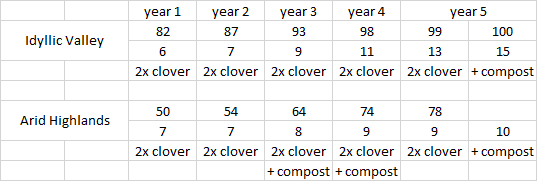
Since v0.7.5f you can see a little tooltip on your fields showing the fertility multiplier (up to 100%). They didn’t mention it in the patch notes, but it’s there now.
So I wouldn’t be surprised to see something similar for fodder quality. Would explain why you get +40% +40% on Idyllic and only +40% +29% on Lowland Lakes. Obviously a low fodder quality doesn’t mean lower regeneration/fodder gains, so that’s different to farming fertility. Or maybe the fertility level of a spot matters for how much fodder quality is regenerated?
Hope you still have your old data! 
